Around Goolwa and the World in March 1943
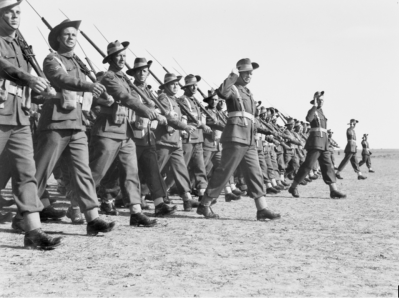
Goolwa goes to war again 1939-1945
MARCH 1943 This month 80 years ago by Frank Tuckwell
Japanese air raids on Darwin resume this month with a flight of Kate level bombers accompanied by zero fighters for an attack on March 2nd RAAF bases. In a daylight raid, they attacked the Coomalie Creek airstrip located in the bush approximately 90kms south of Darwin and 15kms from Batchelor Airfield. Currently, the 87th Reconnaissance Squadron operate from this strip equipped with De Haviland Mosquito and Beaufighter aircraft flying on missions to Timor and Indonesia. In the ensuing battle over Coomalie airstrip, Spitfires shot down one Kate bomber and two Zero fighters.
Five days later a Japanese reconnaissance plane, a fast twin engine Mitsubishi aircraft, code named Dinah by the Allies flew over the southern group of airstrips on the Stuart Highway. The RAAF 457 squadron was scrambled, and its Spitfires intercepted and shot down the intruder.
A week later, on the morning of March 15, a large flight of Japanese aircraft made up of 21 bombers and 24 Zero fighters made an attack on Darwin and the waterfront. The damage appeared to be concentrated around the waterfront leaving two oil tanks burning near the wharf. Squadron 54 operating out of Darwin Civil Airport took on the Japanese inflicting heavy losses on the enemy aircraft. Seven bombers were shot down with the loss of three Spitfires and one pilot.
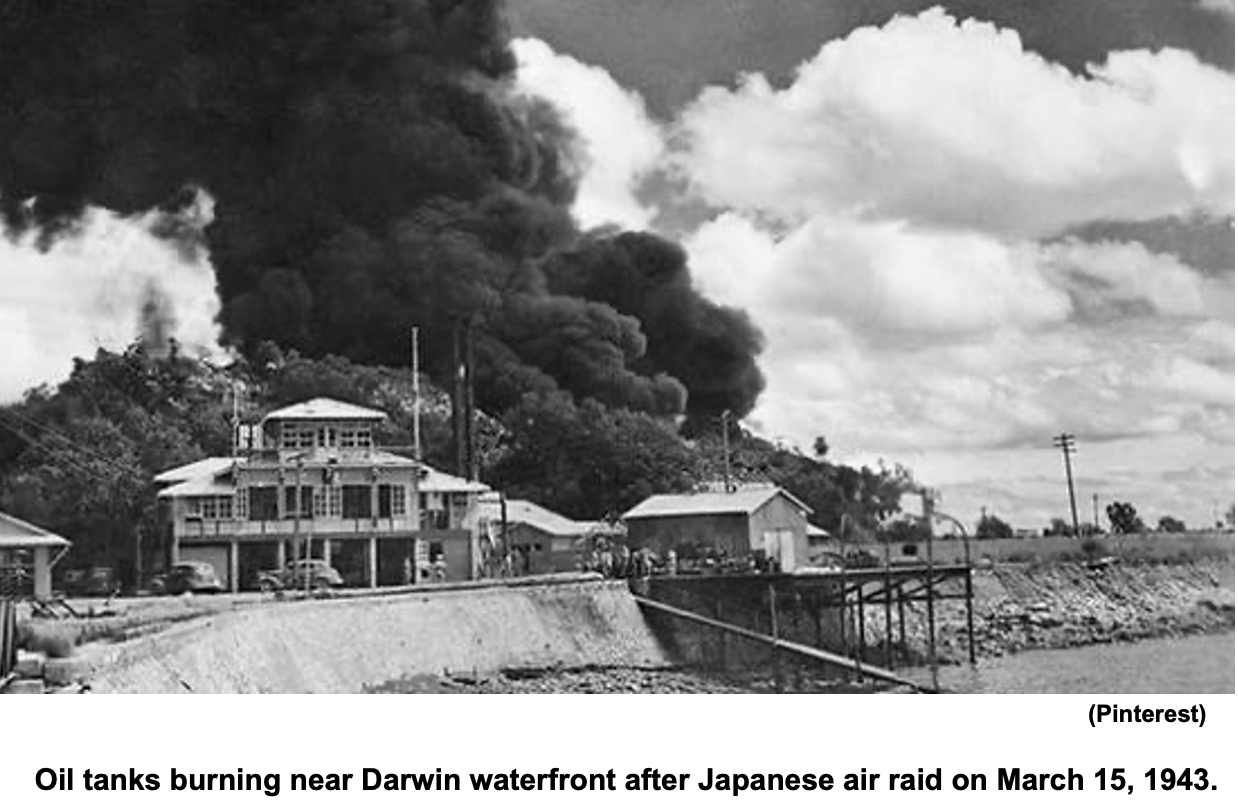
The Battle of the Bismarck Sea, March 2nd – 4th 1943
Allied intelligence services have suspected that the Japanese have planned to land a significant force of troops on the PNG north coast to reinforce their depleted forces there. Naval codebreakers working both in Melbourne and Washington had listened in to the enemy’s signal traffic, decrypting and translating their messages.
The information revealed that on February 28, a fleet of eight destroyers and eight troop transports carrying a total of seven thousand troops, together with an escort of approximately one hundred fighter aircraft had sailed from Rabaul destined for the PNG coast. They were not sighted due to heavy storm clouds until a patrolling B24 Liberator spotted them in a break in the clouds at mid-afternoon on March 1.
Next day, the Japanese fleet was still benefiting by the storm cover until 10am when another Liberator sighted them and called in a report. A flight of US 5th Airforce B17 Flying Fortresses on standby were sent into an attack on the clearly visible ships. Relays of these heavy bombers attacked the fleet throughout the day.
The Japanese have now suffered the loss of one troop transport sunk with several other ships being hit. One US B17 was shot down by escorting Zero fighters during the day. With coming on of darkness the Allied air strategy changed to surveillance during the night as RAAF Catalina flying boats of 11 Squadron from Port Moresby took up the role of trailing the convoy.
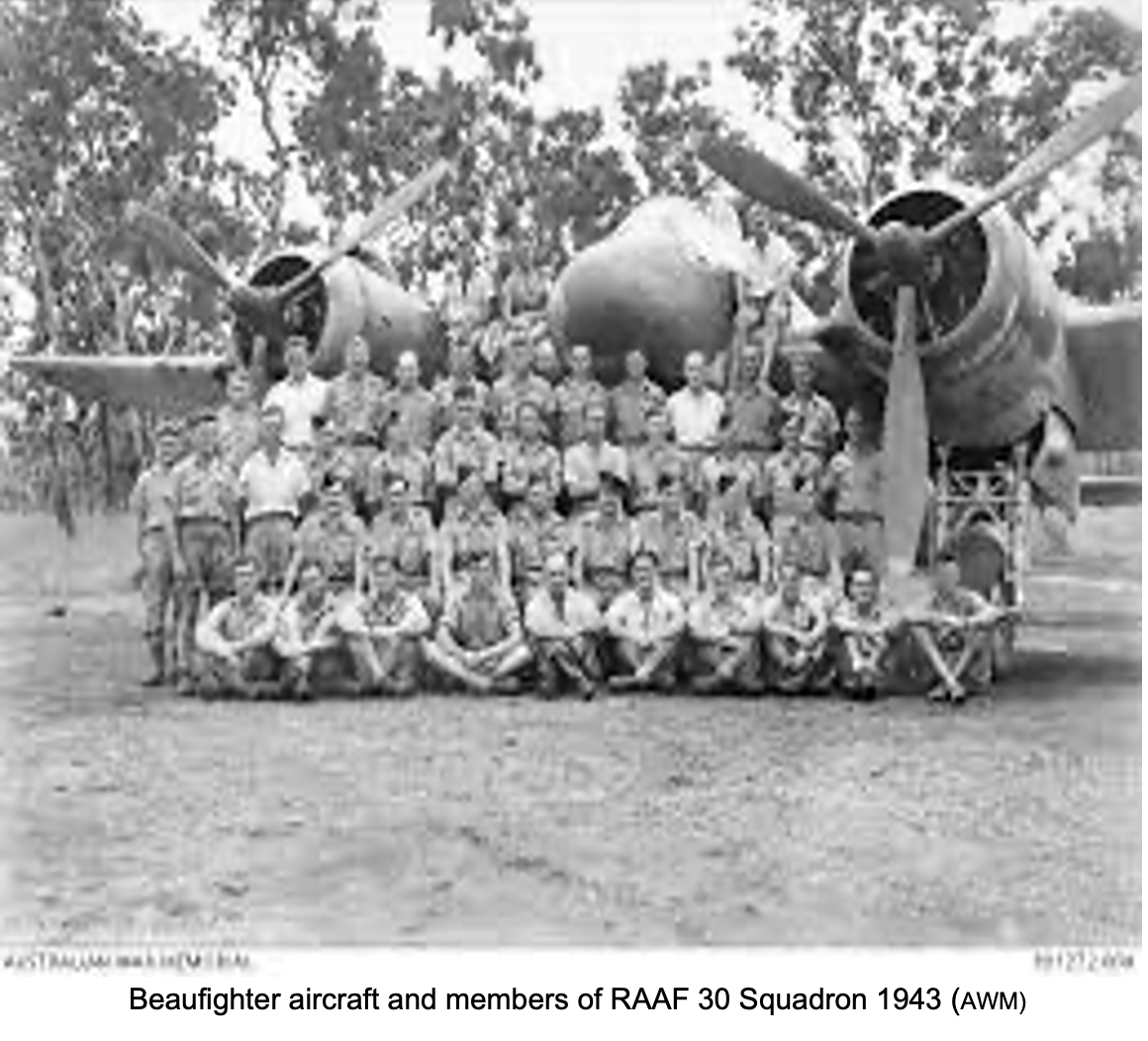
Next day, March 3, dawned to clear skies with the Japanese convoy now turning to run down along the Huon Peninsula passage of the PNG coastline coming into range of light bombers and fighters. Over 90 aircraft of the Allied air forces were airborne to mount an attack on the convoy, including a flight of Boston bombers of RAAF 22 Squadron based in Port Moresby.
At 9.30am the combined Allied air force assembled over Cape Ward Hunt, and by 10.am the Battle of the Bismarck Sea had begun, joined by 13 Beaufighters from RAAF No. 30 Squadron from an anti-shipping and ground support unit from Port Moresby.
The three-day Battle of the Bismarck Sea ended on March 4, resulting in a devastating defeat of the Japanese navy with the loss of eight troop transport ships and four destroyers sunk, 20 fighter aircraft downed, and an estimated 2,890 deaths. On the Allied side the victory had been won convincingly with the loss of two bombers and four fighters downed and thirteen killed in action.
Among the RAAF squadrons and their personnel operating through the New Guinea and Darwin combat areas as well as elsewhere overseas, are those who enlisted from Goolwa, including Jack Berkshire, Glen Thompson, Keith Neighbour (POW), John Sharp, Wal Balfour-Ogilvy, Merv Ward, Hartley Newell, Les Langford, Peter Madsen, Ralf Ness, Sel Rogers, and Jack Green. They took a vital part in various roles mainly in aircraft maintenance and ground support as well as the aircrew flying the craft they maintained.
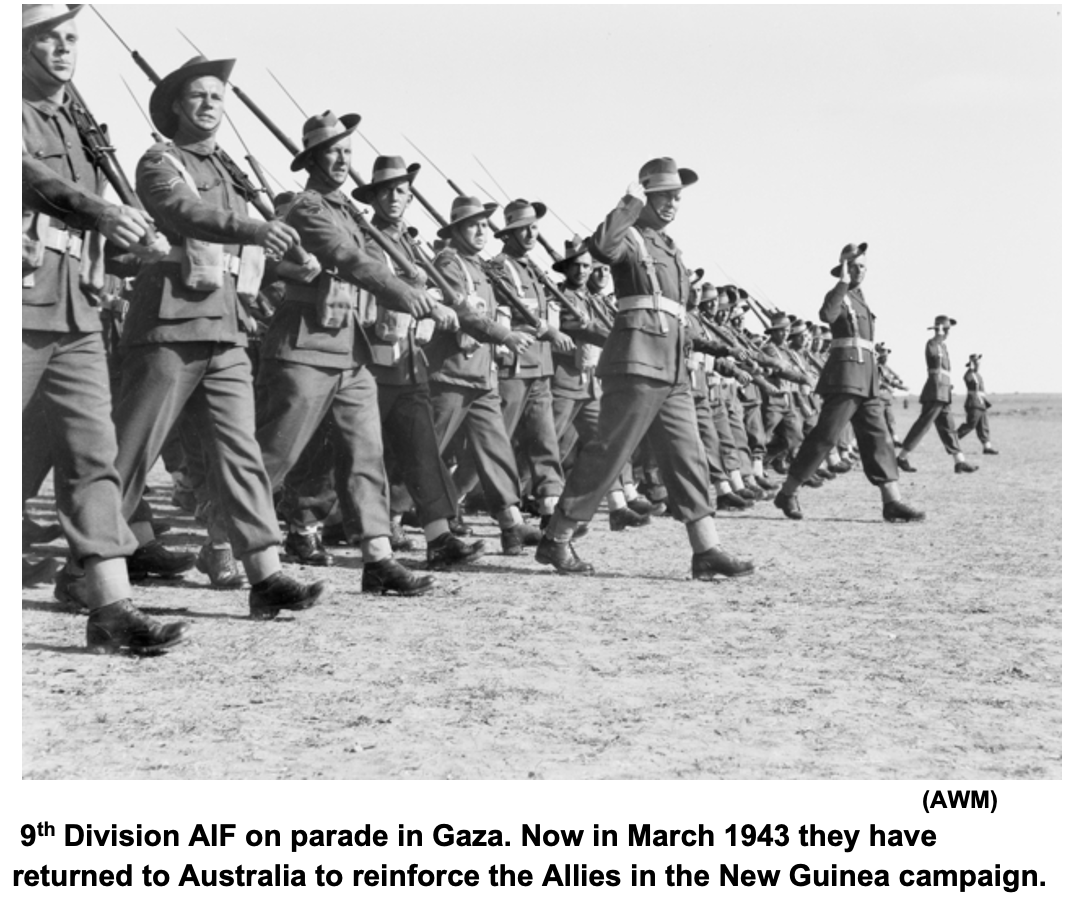
9th Division AIF stirs national pride with its march through Adelaide
A huge crowd estimated at two hundred thousand lined the length of the parade to witness the SA members of the 9th Division as they marched through and around Adelaide on Friday 26th while being wildly cheered by the enthusiastic public.
Taking their place in the crowd lining the city streets were many Goolwa folk who took the morning train from the local station to view the troops, many with personal connection with the marchers as the wives, children, mothers, siblings, or other family connection. For these in a few hours they will spend some time together to give their farewells before the unit will leave for jungle training in just three days’ time.
The troops assembled at the Torrens Parade ground and commenced their seven-mile march through the city from Victoria Drive setting off at 1.05pm down a route from King William Road, King William Street to South Terrace, then along Unley Road to Cross Road, turning west to Goodwood Road and finally into Daws Road. They had regular rest stops along the way and completed the march by 4pm.
Earlier in the march the troops passed the saluting stand at the Adelaide town Hall where they took the salute from State Governor Sir Malcolm Barclay-Harvey. Other VIPs on the saluting platform were SA Premier, Tom Playford together with the Lord Mayor, senior unit officers of the 9th Division, and other dignitaries.
Goolwa has spent the past three weeks with their locally enlisted men of the 9th Division who came home on extended leave. It was understood that after the leave period members would be leaving for jungle warfare training and will embark by rail from Adelaide, bound for Queensland on the Atherton Tablelands to begin their jungle training.
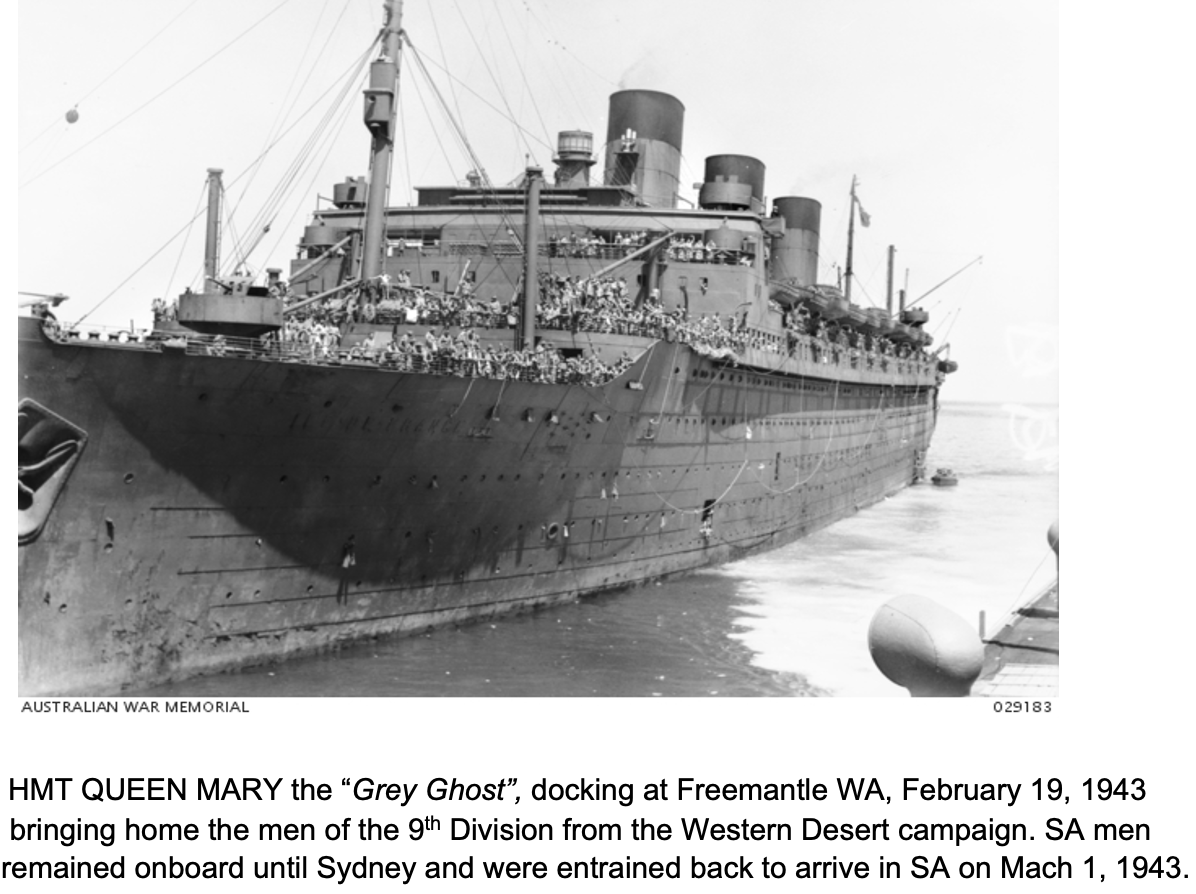
Goolwa service personnel return home on leave
A little brightness had come back to the Goolwa township as the men of the 9th Division who enlisted from the village to go to war, were back in the fold on three weeks leave from March 1. They mixed with other servicemen also home on leave from other units. One of those who missed out in getting home from the 9th was Arthur Tuckwell, who had been admitted to hospital in Jerusalem in a serious condition from a malaria-like illness, missing the first of the AIF shipments home. Meanwhile he had been posted out of the infantry and transferred to make up numbers in an urgently needed Army Hospital Laundry and Field Decontamination Unit that was being put together from troops awaiting embarkation to Australia. He expects to be sent directly to New Guinea to his new unit when discharged from hospital.
Twice wounded Dave Evans now looking tanned and fit, and with jolly Jack Dodd now suffering from considerable loss of hearing from prolonged heavy artillery fire and unsure of his future army days, are glad for the break from duties. Also on home leave is Sid Amey, who in May 1941 lost one leg below the knee and almost lost the other one but saved in time by skilled surgeons in the field at Tobruk. He was shipped home in September 1941, before the 7th Division returned to Australia in March 1942. Sid is progressing well and is receiving therapy prior to his release from the army.
George Godfrey is still critically ill and showing little improvement from his facial wounds, is at present in Heidelberg Army Hospital in Victoria. Alf Tuckwell, of the 7th Division, is on the endangered list and in decline resulting from his home-bound troopship accident injuries, is in Keswick Army Hospital but is not showing any signs of recovery. However other returning members, Doug Armfield, Max Byrnes, Keith Lang, Alf Laidler, Jock Sauerbier, Lloyd Bedford, and Guy Baird are all in excellent health.
Goolwa RAAF serviceman killed in city road accident
On Thursday March 25th LAC Glen Alphred Thompson1 of the RAAF Adelaide Wireless Telegraph Station unit, was on duty when killed instantly in a road accident when the motorcycle he was riding skidded while trying to avoid a collision with a truck on Unley Road.
Glen had recently been posted to Adelaide after serving for a period in the New Guinea area in a squadron based at Port Moresby. He was a 20-year-old fitter and turner who had enlisted in Goolwa on December 13, 1940. Glen was the son of Alf and Mary Thompson, dairy farmers from Hindmarsh Island.
Goolwa men and women continue to sign up for the duration
Back home the Manpower authorities are allowing volunteers for military service overseas to be released from reserved essential occupations in munitions and food production as more women are filling the need for workers in the national war labour force. On farms and in factories women are developing skills in driving tractors and trucks or operating lathes and other manufacturing machinery, thus allowing fit and active men and women to obtain Manpower release to join military service.
In the past few weeks two local women, Gladys Crouch and Elizabeth Dodd enlisted together on the same day at Goolwa to join the Australian Women’s Army Service (AWAS). From Hindmarsh Island’s Madsen family, Peter Madsen was released from the cheese factory to enlist in the RAAF. This month Ralph (H.R) Goode enlisted in the army and Margaret Smith2 joined the AWAS.
___________________________________________________________________
Footnotes:
1. Glen Thompson’s initials as inscribed on the memorial in the Goolwa Soldiers Memorial Gardens incorrectly show ‘G.H.’ instead of (G. A.)
2. Margaret Smith is the daughter of Pte Colin Smith, taken prisoner of war by the Japanese at the fall of Singapore in 1942.